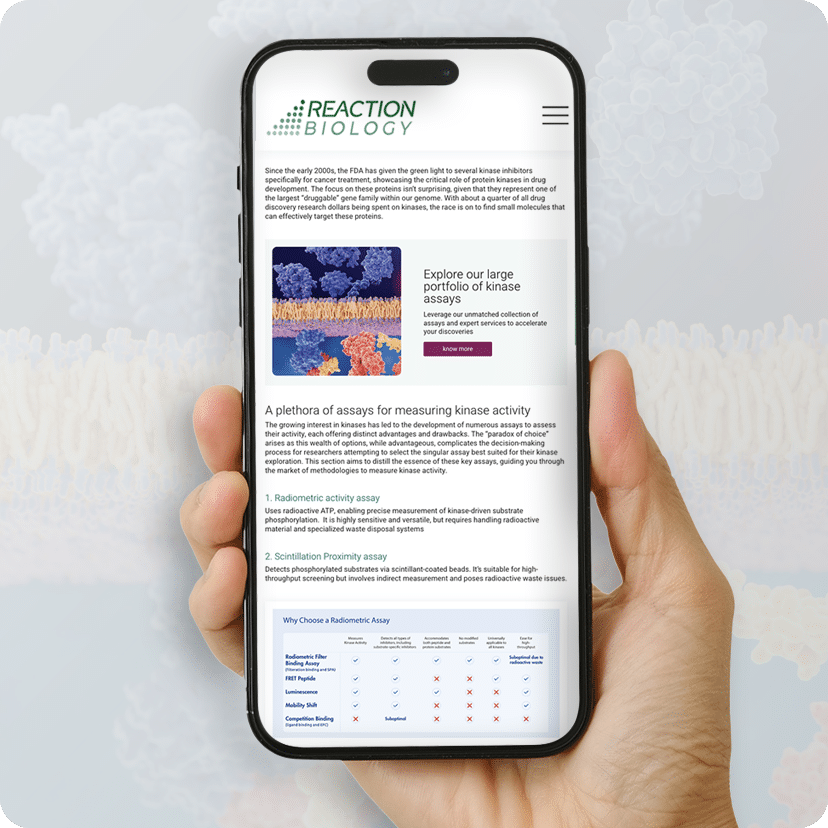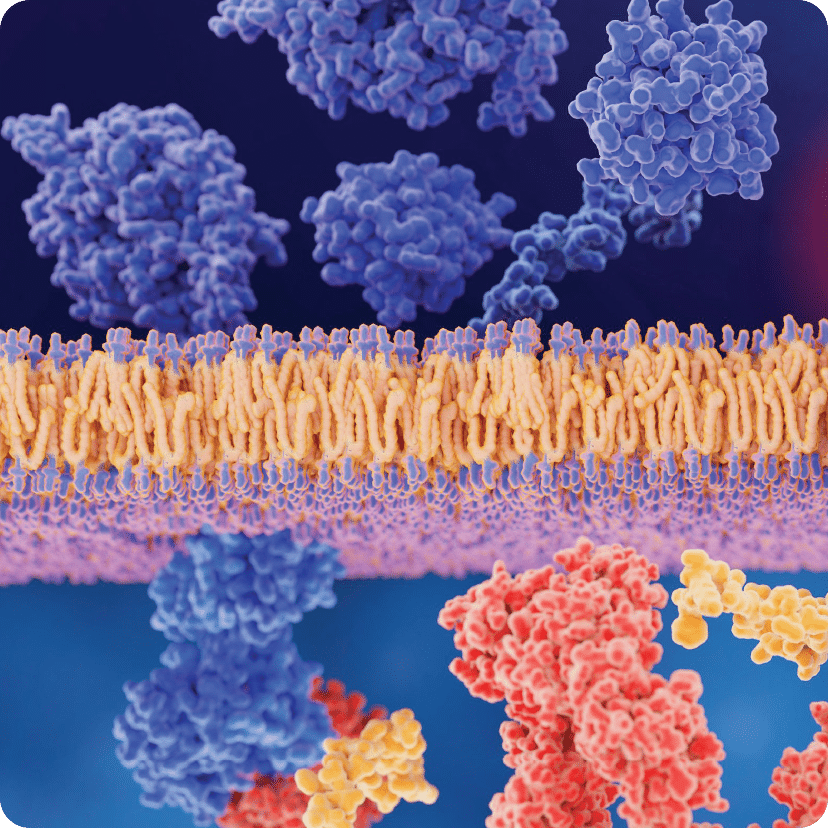Step-by-Step Guide to Kinase Inhibitor Development
Kinase inhibitors hold promise for treating diseases like cancer. This blog unveils the multi step process of bringing a drug candidate to market, specifically focusing on lead identification and optimization using an array of biochemical, biophysical, cellular, and in vivo assays. Explore how science transforms promising compounds into potential new treatments.
The journey of kinase drug discovery is a fascinating tale, sparked by Nobel Laureate Edmund Fischer’s discovery of protein phosphorylation. With the identification of over 500 protein kinases in the human genome, their crucial role in cellular regulation became clear. However, harnessing their potential for therapeutic purposes initially seemed daunting due to the high similarity in the active sites of these kinases and the difficulty in specifically inhibiting one kinase without affecting others. Most compounds targeted the ATP-binding site, and the high cellular concentration of ATP made achieving specificity and potency challenging. Despite these hurdles, the field has advanced significantly since the approval of the first kinase inhibitor, imatinib, in 2001. Today, kinases remain the largest class of “druggable” targets, with more than 80 FDA-approved agents that target about two dozen protein kinases. This step-by-step guide will unveil the essential stages of kinase discovery, from evaluating their activity to preclinical testing.
Evaluate Kinase Activity
The first step in kinase inhibitor discovery is to evaluate whether your compound truly inhibits its target. This can be achieved using biochemical assays which help determine the activity, potency and selectivity of your compound. Here’s how you can approach this step:
- Select Appropriate Assay Format: a variety of assay format are currently available that use different detection methods to measure the kinase activity including radiometric assay, enzyme-linked immunosorbent (ELISA) assay, luminescent or fluorescence-based assays
- Measure Inhibitory Potency: Assess the IC50 value, which is the concentration of your compound needed to inhibit 50% of the kinase activity to guide your med chem optimization of kinase selectivity and rule out off-target effects
- Compare with Controls: Use known inhibitors as positive controls to validate your assay results.

Learn from our blog:
Choosing the right assay for determining kinase activity
Decipher Mechanism of Action
Once you’ve confirmed that your compound inhibits its target kinase, the next step is to understand how it does so. Deciphering the mechanism involves validating the binding of your selected inhibitor(s):
- Binding Studies: Use techniques such as surface plasmon resonance (SPR) or isothermal titration calorimetry (ITC) to study the binding interactions between your compound and the kinase.
- Kinetic Analysis: Determine whether your inhibitor acts competitively or non-competitively by assessing its binding characteristics. Kinase inhibitors (KI) can bind to the same site as ATP, the kinase substrate, or in a mixed manner. Changes in ATP or substrate concentrations affect the compound’s potency, providing insights into its mode of action (MoA).
- Structural Studies: When the interaction is complicated or undetermined, you may employ X-ray crystallography or cryo-electron microscopy to visualize how your compound interacts with the kinase at the molecular level.
This understanding is crucial for optimizing inhibitors with the desired specificity and efficacy.
Kinase Profiling
To ensure that your compound is specific to the target kinase and does not affect other kinases, conduct kinase selectivity profiling. This step is vital to minimize off-target effects, which can lead to unwanted side effects in patients:
- High-Throughput Screening: Screen your compound against a panel of kinases representing the human kinome.
- Selectivity Index: Calculate the selectivity index by comparing the inhibitory potency of your compound against the target kinase and other kinases.
- Off-Target Analysis: Identify any kinases that are significantly inhibited by your compound and assess the potential impact on therapeutic outcomes.
By thoroughly profiling kinase selectivity, you can refine your compound to enhance its specificity.

On-target & Off-Target Kinase Profiling
Based on the industry's largest human kinome collection
Target Engagement
After establishing activity, potency, and selectivity via biochemical means, the next step is to evaluate the selectivity of your kinase inhibitor in a cellular context using advanced cell-based assays:
- Functional Assays: Measure the activity of your compound on cellular signaling pathways.
- Biomarker Studies: Identify biomarkers that can indicate target engagement and measure their levels in treated cells.
- Live-Cell Imaging: Utilize live-cell imaging techniques to observe the real-time effects of your compound on target kinase activity within cells.
Evaluating target engagement in a cellular environment ensures that your compound is effectively inhibiting the kinase within the biological context.

HotSpot™ Kinase Screen
Test kinase activity at physiological ATP levels with our best-in-class radiometric assay
Preclinical testing
The final step in the kinase discovery process is to test the in vitro and in vivo efficacy and safety of your compound. Preclinical testing involves several critical activities:
- In Vitro Efficacy: Assess the therapeutic potential of your compound using various cell lines and disease models.
- In Vivo Studies: Conduct animal studies to evaluate the pharmacokinetics (PK), pharmacodynamics (PD), and overall safety profile of your compound.
- Toxicity Testing: Perform comprehensive toxicity studies to identify any adverse effects and establish safe dosage levels.
Preclinical testing is crucial to ensure that your compound is both effective and safe before advancing to clinical trials.
Conclusion
Kinase discovery is a meticulous process that demands a systematic approach to identify effective and safe inhibitors. By following these steps—evaluating kinase activity, deciphering the mechanism of action, profiling kinase selectivity, assessing target engagement, and conducting preclinical testing—you can adeptly navigate the complexities of hit-to-lead or lead optimization. These steps are crucial milestones toward developing promising therapeutic candidates poised for clinical advancement.
Reference
- Cohen P, Cross D, Jänne PA. Kinase drug discovery 20 years after imatinib: progress and future directions. Nat Rev Drug Discov. 2021 Jul;20(7):551-569. doi: 10.1038/s41573-021-00195-4. Epub 2021 May 17. PMID: 34002056; PMCID: PMC8127496.
- Roskoski R Jr. A historical overview of protein kinases and their targeted small molecule inhibitors. Pharmacol Res. 2015 Oct;100:1-23. doi: 10.1016/j.phrs.2015.07.010. Epub 2015 Jul 21. PMID: 26207888.
- Anderson B, Rosston P, Ong HW, Hossain MA, Davis-Gilbert ZW, Drewry DH. How many kinases are druggable? A review of our current understanding. Biochem J. 2023 Aug 30;480(16):1331-1363. doi: 10.1042/BCJ20220217. PMID: 37642371; PMCID: PMC10586788.